- Submissions

Full Text
Peer Review Journal of Solar & Photoenergy Systems
PV Syst Based Modeling and Validation of Photovoltaic Cells
Bouzguenda M1, Selmi T2* and Natarajan R2
1 College of Engineering, KSA
2 Department of Electrical and Mechatronics Engineering, Oman
*Corresponding author: Tarek Selmi, Department of Electrical and Mechatronics Engineering, Oman
Submission: December 20, 2018;Published: April 22, 2019

Volume1 Issue3 April, 2019
Abstract
Photovoltaic (PV) cells are modeled using numerical models that illustrate the performance of the voltage and the current generated by the PV cell. Those two physical quantities depend on some manufacturing and environmental parameters such as the temperature and the incident irradiance. Accordingly, this paper shows the impact of such parameters on the electric behavior PV cells. An electronic circuit; made up of a photocurrent source, a junction diode of two semiconductor materials, N-type and P-type, a series and shunt resistances; represents the PV cell considered within this paper. Within this paper, real data of the AEGAS-P605-250 PV module has been used through PV syst. 6.6.3 Software Tool to highlight to impact of manufacturing and climate parameters on the cell’s electric behavior.
Keywords: Photovoltaic; Cell; Modeling; Semiconductor; Junction; Voltage; Current; Shunt; Series
Introduction
The functioning of a PV cell is depends primarily on the ability of the photons to free electrons from the semiconductor generating electricity. In the external circuitry, the electrons are channeled toward the load at the output terminal of the PV cell resulting in a DC current from the positive terminal to the negative one [1-5]. The average generation capacity is reported be one volt in each cell. In order to achieve the desired production capacity, the PV cells have to be interconnected in series and/or in parallel to produce an acceptable output voltage level to be used by end users. In order to maximize the efficiency, continuous research investigations are conducted by manufactures attempt to optimize the environmental parameters of PV cells [6-9]. The common characterization studies of PV cells involve plotting the curves I(V) or P(V) of a PV cell. These two characteristics are used to determine the current and the voltage at the maximum power point (IMPP and VMPP), the opencircuit voltage (VOC), the short-circuit current (ISC), the fill factor (FF) and the efficiency (η) of the PV cell [10].
The two most commonly equivalent circuit models used to model solar cells are singlediode model (SDM) and double-diode model (DDM) [11,12] which are illustrated in Figure 1. They are both made up of a photocurrent source (Iph), one diode (for the SDM) and 2 diodes for the (DDM), a shunt and series resistances (RSH) and (RS), respectively.
SDM

Where IS,IS1 and IS2 are the saturation current of the diodes, q is the electrostatic charge (1.6x10-19C), n, n1 and n2 are the ideality factors, K is Boltzmann’s constant (1.38e-23 J.K -1) and T is the temperature.
Experimental Methods
At the cells’ terminals, the measured voltage and current are Vpv and Ipv respectively. When the circuit is open, the open-circuit voltage (VOC) is given by Equation 3:

The short-circuit current (ISC) can be expressed as Equation 4:

The impact of the electrical and surrounding parameters alterations on the behavior of the PV cell could be clearly seen by plotting the waveforms of the current versus the voltage or the power versus the voltage as function of such parameters. Furthermore, the efficiency of the PV cell, which is the ratio of the actual output power to the theoretical output power and expressed as percentage, could be as well plot as function of the incident irradiation and the cell’s temperature.
Figure 1:PV Cell electric models. a) single-diode model. b) two-diode model.

Results and DISCussion
Influence of the incident irradiation on the PV module performance
The incident irradiation is the most significant parameter that affects the output power of the PV module. In fact, as shown in Figures 2a & 2b, both the voltage and the current are proportional to the incident irradiation. It was observed that the output power of the PV module increased with increase incident radiation. It is clear that under STC, the maximum output power achieved from the PV module is around 229W. Regardless of the negative influences of dust accumulation on PV modules, humidity and high temperature, Oman has very high incident irradiation level providing a significant potential for PV systems utilization. Studies on PV system performance under different environmental conditions reported similar observations [13-16].
Figure 2:Influence of the incident irradiation on the performance of the PV module at T=45 °C (a) I(V), (b) P(V).
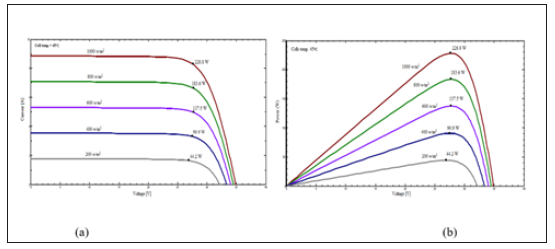
Influence of temperature on PV module performance
In this set of experiments, the effect of ambient temperature on the PV system was studied at fixed incident radiation. The temperatures were varied in the range of 10 to 70 °C and its effect on the power output was measured. The temperature of the PV cell is inversely proportional to the PV module output power, as shown in Figure 3. Many PV cells/module parameters are temperature-dependent, but the most significant effect is due to the intrinsic carrier concentration of the semiconductor. In fact, the concentration depends on the band gap energy. When the band gap is lower, the higher the intrinsic carrier concentration and it influenced the output capacity of the PV system.
Figure 3:Temperature dependence of the PV module for an incident irradiation of 1000W/m2 (a) I(V), (b) P(V)..
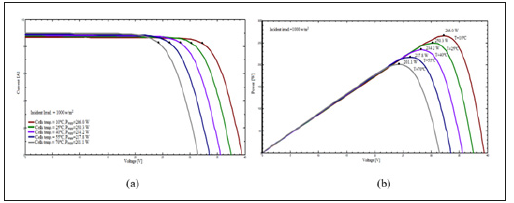
Influence of Rs on the PV module performance
Within this research work, the resistance has been varied from 0.200 to 1.000Ω. Figure 4 (a) and (b) show an inverse proportionality between series resistance and output power. When the series resistance was increased, output power of the PV module was decreased. In fact, the series resistance is on the path of the current towards the external circuitry where always a drop of both the output voltage and current of the PV cell exist. This leads to a reduction on the output power of the PV module.
Figure 4:Influence of the series resistance on the performance of the PV module. (a) I(V), (b) P(V), for different series resistance values.
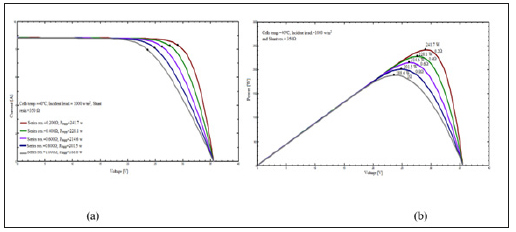
Influence of RSH on the PV module performance
Based on Figure 1, the shunt resistance will resist to a portion of the current that is subtracted from the photocurrent Iph. Accordingly, when the shunt resistance increases, the efficiency of the PV cell increases leading to power improvement as shown in Figures 5a & 5b.
Efficiency of PV module versus electrical and environmental parameters
Obviously, since the output power of the PV module is dependent on the temperature, the incident irradiation, the series resistance and the shunt resistance, its efficiency will be affected by such parameters. Figure 6-9 are in full agreement with what has been described in previous sections. The efficiency of the PV module was observed to be proportional to the incident irradiation and the shunt resistance. But, an inversely proportional relation to the temperature and the series resistance was observed with respect to the efficiency. However, these cell parameters are dependent on the manufacturing process and material configuration used. Evidently, the consumer is not, in anyway, able to adjust the shunt resistance of the PV module. However, tilt angle can be adjusted, and the PV system can be cleaned from dust deposit to receive higher incident irradiation level [17-22].
Conclussion
This paper has demonstrated and validated the effect of different manufacturing and environmental parameters on the design and performances of the PV cells. It has been shown clearly that the temperature and the efficiency of the PV cell are inversely proportional to the system efficiency while the efficiency of the cell is proportional to the incident irradiance. It was concluded that higher the temperature, the lower the cell’s efficiency and the more the incident irradiance the higher the efficiency of the PV cell. The successful operation of any PV system was proved to be environmental factors dependent and relied on the manufacturer’s production methods and material of construction.
Figure 5:Influence of the shunt resistance on the performance of the PV module. (a) I(V), (b) P(V), for different shunt resistance values. .
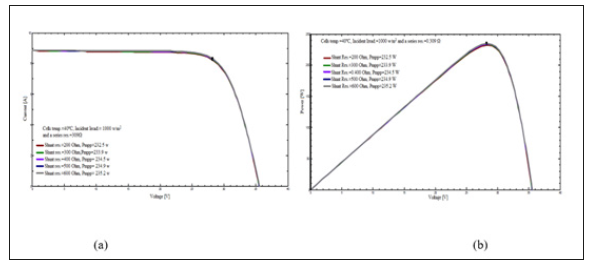
Figure 6:Efficiency versus temperature for different incident irradiation levels.

Figure 7:Efficiency versus incident irradiation levels for different temperature levels..

Figure 8:Efficiency versus incident irradiation for different series resistances.
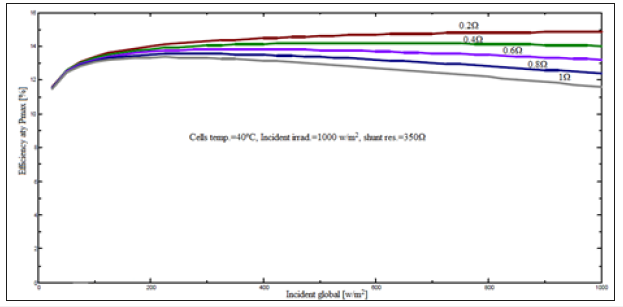
Figure 9:Efficiency versus incident irradiation for different series resistances.

References
- Tarabsheh AA, Akmal M, Ghazal M (2017) Series connected photovoltaic cells-modeling and analysis. Sustainability 9(3): 371.
- Hernanz R, Martín C, Belver Z, Lesaka L, Guerrero Z, et al. (2010) International conference on renewable energies and power quality (ICREPQ’10), Granada (Spain), 23th to 25th March.
- Hossain J, Sakib N, Hossain E, Bayindir R (2017) Modeling and simulation of solar plant and storage system: A step to microgrid technology. International Journal of Renewable Energy Research 7(2): 723-737.
- Singh S, Kumar R, Kumar K (2017) Designing and modeling of real-time identification of optimal operating points in photovoltaic power systems. International Journal of Engineering and Management Research 7(4): 346-354.
- An SD, Poudel P, Bae SH, Park KW, Jang B (2017) Improved photovoltaic MATLAB modeling accuracy by adding wind speed effect. 10(1): 58-63.
- Liu Y, Lu N (2016) Co-simulation of photovoltaic power system based on Lab VIEW and Simulink. Chinese Journal of Power Sources (10): 1987- 1989.
- Sakib N, Hossain J, Hossain E, Bayindir R (2017) Modeling and simulation of natural gas generator and EV charging station: A step to microgrid technology. International Journal of Renewable Energy Research 7(1): 399-410.
- Sakib N, Hossain J, Bulbul HI, Hossain E, Bayindir R (2016) Implementation of unit commitment algorithm: A comprehensive droop control technique to retain microgrid stability. IEEE International Conference on Renewable Energy Research and Applications (ICRERA), Birmingham, England pp. 1074-1079.
- Longo M, Zaninelli D, Viola F, Romano P, Miceli R (2015) Electric vehicles impact using renewable energy. 10th International Conference on Ecological Vehicles and Renewable Energies.
- Ayaz R, Nakir I, Tanrioven M (2014) An improved MATLAB-simulink model of PV module considering ambient conditions. International Journal of Photoenergy pp. 1-6.
- Liang TH (2010) Insolation-oriented model of photovoltaic module using Matlab/simulink. Solar Energy 84(7):1318-1326.
- Etienne S, Alberto T, Mikhaïl S (2011) Explicit model of photovoltaic panels to determine voltages and currents at the maximum power point. Solar Energy 85(5): 713-722.
- Kashif I, Zainal S, Hamed T (2011) Simple, fast and accurate two-diode model for photovoltaic modules. Solar Energy Materials and Solar Cells 95(2): 586-594.
- Sheriff MA, Babagana B, Maina BT (2011) A study of silicon solar cells and modules using PSPICE. World J Appl Sci Technol 3(1): 124-130.
- Nema RK, Savita N, Gayatri A (2009) Computer simulation based study of photovoltaic cells/modules and their experimental verification. International Journal of Recent Trends in Engineering 1(3): 151-156.
- Kashif I, Zainal S, Hamed T, Syafaruddin (2011) Modeling and simulation of photovoltaic (PV) system during partial shading based on a two-diode model. Simulation Modelling Practice and Theory 19(7): 1613-1626.
- Patel H, Agarwal V (2008) MATLAB-based modeling to study the effects of partial shading on PV array characteristics. IEEE Transactions on Energy Conversation 23(1): 302-310.
- Kashif I, Zainal S, Syafaruddin (2011) A comprehensive MATLAB Simulink PV system simulator with partial shading capability based on two-diode model. Solar Energy 85(9): 2217-2227.
- Salmi T, Bouzguenda M, Gastli A, Masmoudi A (2012) MATLAB/simulink based modeling of solar photovoltaic cell. International Journal of Renewable Energy Research 2(2): 213-218.
- Selmi T, Belghouthi R (2017) A novel widespread Matlab/simulink based modeling of InGaN double hetero-junction p-i-n Solar Cell. International Journal of Energy and Environmental Engineering 8(4): 273-281.
- Rhouma BH, Gastli A, Brahim LB, Touati F, Benammar M (2017) A simple method for extracting the parameters of the PV cell single-diode model. Renewable Energy 113: 885-894.
- Khanna V, Das BK, Bisht D, Vandana, Singh PK (2015) A three diode model for industrial solar cells and estimation of solar cell parameters using PSO algorithm. Renewable Energy 78: 105-113.
© 2018 Selmi T. This is an open access article distributed under the terms of the Creative Commons Attribution License , which permits unrestricted use, distribution, and build upon your work non-commercially.
 a Creative Commons Attribution 4.0 International License. Based on a work at www.crimsonpublishers.com.
Best viewed in
a Creative Commons Attribution 4.0 International License. Based on a work at www.crimsonpublishers.com.
Best viewed in 







.jpg)






























 Editorial Board Registrations
Editorial Board Registrations Submit your Article
Submit your Article Refer a Friend
Refer a Friend Advertise With Us
Advertise With Us
.jpg)






.jpg)













.bmp)
.jpg)
.png)
.jpg)














.png)

.png)



.png)






